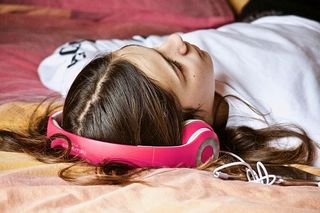
How much sleep do children, and adolescents need? Or to frame the question more specifically, how much do they need for optimal health and performance? That general question is often asked of pediatricians by parents, and the sleep research community has tried to answer the question. Need is most often taken to mean duration of sleep – in hours per night. Several prominent organizations have published guidelines for optimal duration at different ages, including the National Sleep Foundation and the American Academy of Pediatrics.
A related question is how much sleep are children getting? It is relatively easy to answer the question for individual children, but there are surprisingly little data on how much sleep children and adolescents in different ages groups are getting. There is a broad consensus by sleep researchers and the public that children (especially teens) are not sleeping enough, but little is known about how far the gap is between actual and ideal durations. How is such information obtained? Asking children, teens, and parents is one way, and well-constructed surveys of nationally representative samples have been done. The National Sleep Foundation has conducted poll every year on sleep related topics, and some have been about sleep of children and teens (NSF, 2004;2006). But self-report (parent report in most cases) often lacks reliability and validity. While there is some evidence that parent report corresponds reasonably well to more objective measures, that is the case only when parents keep detailed diaries about their child’s sleep rather than just answering questions (Sadeh, 2008).
Measurement of sleep via objective means is possible with polysomnography, requiring an overnight visit to a hospital or clinic, but having large numbers of children who are not suspected of having a sleep disorder do such sleep studies is not feasible, and it is questionable whether one night in a hospital is representative. Actigraphs, small devices worn on the wrist, provide very good estimates of sleep duration and have been used extensively in pediatric sleep research. More and more smart phones and other devices have sleep tracking functions that can reliably measure sleep duration
A study recently published in the journal Sleep, an official journal of the American Academy of Sleep Medicine, consists of a review of studies that used actigraphs to measure sleep in typically developing children who do not have a sleep disorder. Galland and colleagues (2018) conducted a systematic review for meta-analysis of 79 published studies of children and teens 3-18 years old.
Sleep duration means for different age groups with ranges suggested by NSF are as follows:
Galland et al. study NSF recommended ranges
3-5 year olds 9.68 hrs 10-13 hrs (3-5 year olds)
6-8 year olds 8.98 hrs 9-11 hrs (6-13 year olds)
9-11 year olds 8.85 hrs 9-11 hrs (6-13 year olds)
12-14 year olds 8.05 hrs 9-11 hrs (6-13 year olds)
15-18 year olds 7.40 hrs 8-10 hrs (14-17 year olds)
These data provide the best data available and should be useful to parents, pediatricians and child researchers. Children in all age groups are sleeping slightly below the lower range of recommendations. For the older age groups, Galland et al. (2018) found that there were significant differences between school night and weekend sleep with weekend sleep nearly an hour longer (56 min), suggesting that weekend sleep was making up for sleep debt accumulated over the school week. This result is particularly important because while much of the focus has been on sleep duration, much research has linked sleep quality and schedule regularity to important cognitive, emotional, and health outcomes.
References
Galland et al. (2018). Sleep, 41(4), 1 April 2018, zsy017, https://doi.org/10.1093/sleep/zsy017
National Sleep foundation (2004). https://sleepfoundation.org/sleep-polls-data/sleep-in-america-poll/2004…
National Sleep Foundation (2006). https://sleepfoundation.org/sleep-polls-data/sleep-in-america-poll/2006…
Sadeh, A. (2008). Commentary: Comparing actigraphy and parental report as measures of children's sleep. Journal of Pediatric Psychology, 33(4), 406-407.


